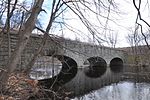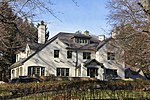Peabody-Williams House
Houses completed in 1891Houses on the National Register of Historic Places in Newton, MassachusettsNewton, Massachusetts Registered Historic Place stubsQueen Anne architecture in MassachusettsShingle Style architecture in Massachusetts ... and 1 more
Shingle Style houses

The Peabody-Williams House is a historic house at 7 Norman Road in Newton, Massachusetts. The 2+1⁄2-story wood-frame house was built in 1891, and is one of the finest Shingle style houses in the Newton Highlands area, with the asymmetrical massing, gabled projections and dormers, and corner turret typical of the style. It was designed by J. Williams Beal, and features extensive interior carving work by a locally prominent woodcarver, Andrew Lees.The house was listed on the National Register of Historic Places in 1986.
Excerpt from the Wikipedia article Peabody-Williams House (License: CC BY-SA 3.0, Authors, Images).Peabody-Williams House
Lakewood Road, Newton Newton Highlands
Geographical coordinates (GPS) Address Nearby Places Show on map
Geographical coordinates (GPS)
| Latitude | Longitude |
|---|---|
| N 42.325555555556 ° | E -71.205 ° |
Address
Lakewood Road 32
02461 Newton, Newton Highlands
Massachusetts, United States
Open on Google Maps










